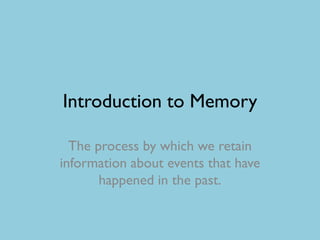
Msm
- 1. Introduction to Memory The process by which we retain information about events that have happened in the past.
- 2. Models of Memory a representation of how memory Developed by Cognitive Psychologists works 2. Working Memory Model – Baddeley & Hitch 1. Multi-store Model – Atkinson & Shiffrin
- 3. Multi-store Model of Memory (MSM) Maintenance rehearsal (Elaborative) Rehearsal Sensory Short Term Long Term External Stimuli Memory Memory Memory (SM) (STM) (LTM) Attention Retrieval Information If STM capacity Information in enters information Information is small, memory the LTM is is attended information that is from the retrieved to then it is not rehearsed rehearsed is environment when needed passed is lost through passed onto and is and can last a onto the displacement the LTM registered by lifetime STM or decay the SM
- 4. Multi-store Model of Memory (MSM) Key words/phrases! Linear process Atkinson & Shiffrin 3 distinct (1968) memory stores Retrieval Attention Constraints e.g. Rehearsal capacity, duration and encoding SM, STM & LTM
- 5. Get to know your components: You need to know the characteristics of each memory store in terms of: o Capacity o Encoding o Duration
- 6. MSM – get to know your components Sensory Memory Iconic Store – Touch Visual input Receives Sight information from the Sound Echoic Store – environment Auditory input Taste Smell Haptic Store – Tactile input Milliseconds
- 7. Sensory Memory Encoding Capacity Duration Very brief Accepts duration Very limited information capacity through all 5 (Sperling ,1960) senses Sperling ,1960 – visual info for Holds the Sperling, 1960 – milliseconds ‘impressions’ of lab exp = iconic information and Baddeley, 1988 – Crowder, 2003 – then they’re Iconic allows us Auditory info for gone! to piece an image 2-3 seconds
- 8. MSM – get to know your components Short Term Memory Receives information Small amount of info from the SM Information not for a short time rehearsed is lost due to decay or Rehearsed displacement information is passed into LTM Decay – Displacement – Limited duration Limited capacity
- 9. Short Term Memory Capacity Encoding Duration 5-9 items Acoustic 0-18 seconds Jacobs (1887) Baddeley used used the digit acoustically span technique similar and Peterson & dissimilar words Peterson used nonsense trigrams
- 10. MSM – get to know your components Receives Long Term Memory information Link between from the STM amount of rehearsal and Via rehearsal strength of memory trace (engram) Infinite capacity Can last a lifetime
- 11. Long Term Memory Capacity Encoding Duration Unlimited Semantic Unlimited Merkle (1988) Baddeley used looked at number semantically of synapses in Bahrick found similar and brain, between that LTM is a dissimilar words 1000 to 1000000 stable memory GB store – school photos
- 12. MSM – A02 Positive Negative - Murdock (1962) - KF - Squire et al (1992) - KF
- 13. MSM – A02 (Murdock) Position Position on on list list 1 floor 16 voice 2 flower 17 front 3 America 18 degree 4 carpet 19 light 5 laugh 20 chief 6 animal 21 radio 7 point 22 paper 8 race 23 ring 9 hair 24 desk 10 boat 25 tree 11 frame 26 vase 12 mirror 27 smile 13 skin 28 Spain 14 circle 29 clock 15 printer 30 green
- 14. MSM – A02 (Murdock)
- 15. MSM – A02 How do you think Murdock provides support for the Multi-Store Model of memory? Supports the idea of the LTM and STM being separate stores Words at the beginning of the Words at the end of the list were list had been still in the STM rehearsed – therefore were Words in the middle of the list had in the LTM been displaced
- 16. MSM – A02 STM = Squire et al prefrontal cortex Biological evidence – LTM = why is this a good thing? hippocampus This is a strength because it provides scientific (biological) evidence of 2 components of memory, identified by the MSM
- 17. MSM – A02 STM = KF severely impaired Demonstrates that it is possible to damage just LTM = intact one store This is a strength because it provides evidence for STM and LTM being unitary stores, as suggested by the MSM
- 18. MSM – A02 STM = KF partially damaged Demonstrates that it is possible to damage part of one store This is a weakness because it goes against the MSM theory that STM is a unitary store, according to MSM is part of the STM is damaged it all should be.